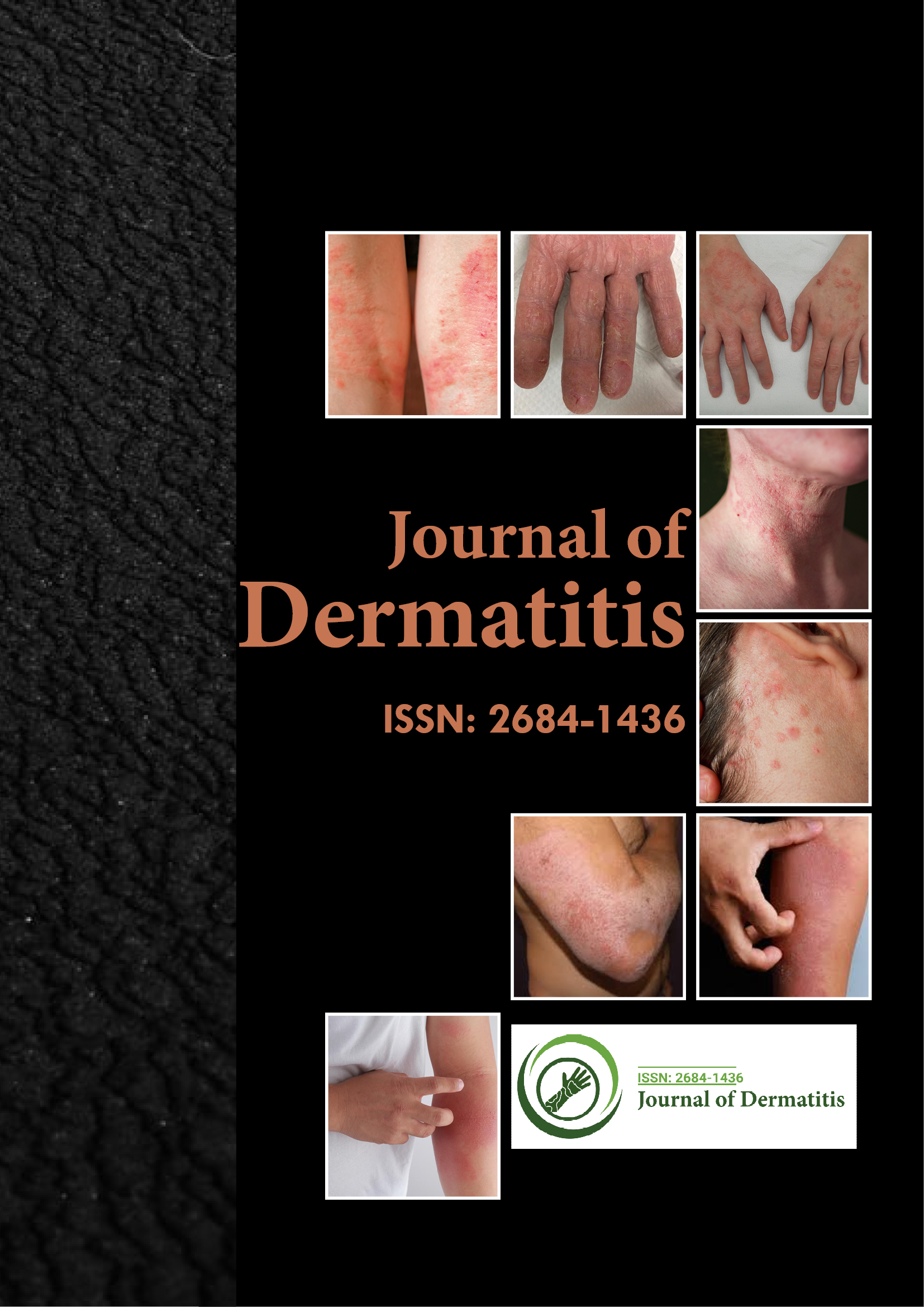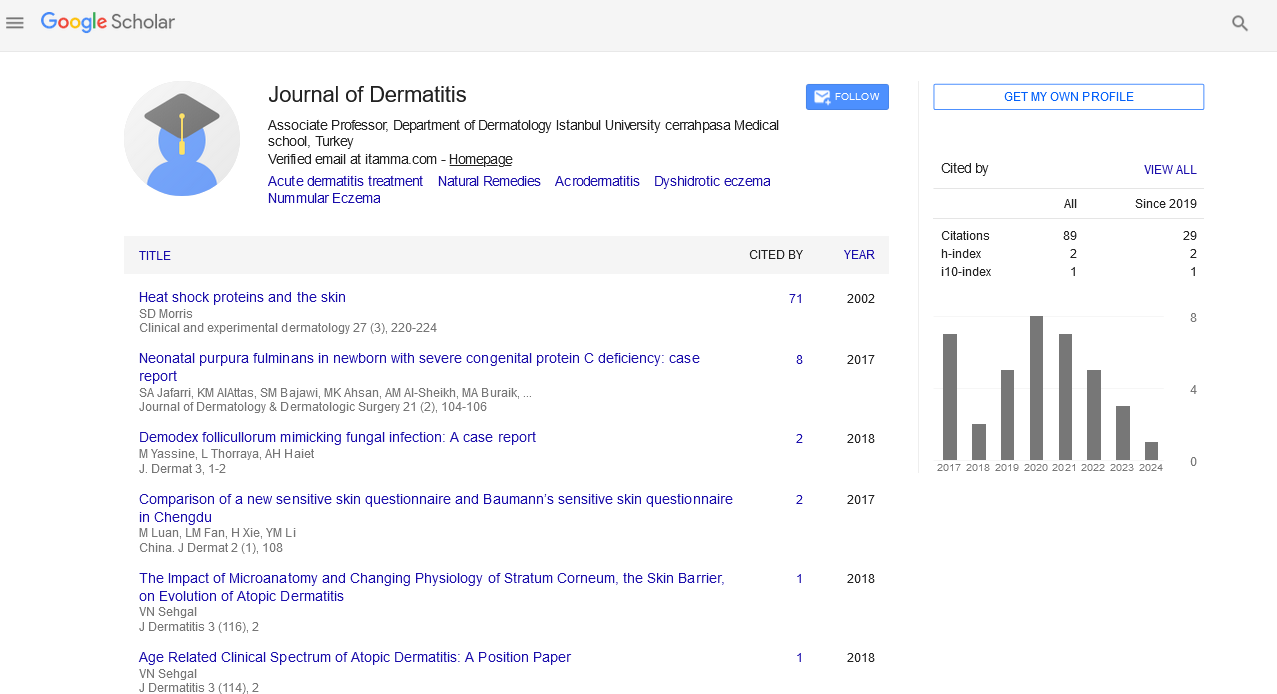Indexed In
- RefSeek
- Hamdard University
- EBSCO A-Z
- Euro Pub
- Google Scholar
Useful Links
Share This Page
Journal Flyer

Open Access Journals
- Agri and Aquaculture
- Biochemistry
- Bioinformatics & Systems Biology
- Business & Management
- Chemistry
- Clinical Sciences
- Engineering
- Food & Nutrition
- General Science
- Genetics & Molecular Biology
- Immunology & Microbiology
- Medical Sciences
- Neuroscience & Psychology
- Nursing & Health Care
- Pharmaceutical Sciences
Editorial - (2021) Volume 6, Issue 6
A Detailed Description of Seborrheic Dermatitis
David Song*Received: 05-Nov-2021 Published: 26-Nov-2021, DOI: 10.35248/2684-1436.21.6.e142
Description
Seborrheic dermatitis is a common, non-contagious, easy to treat skin condition. This type of dermatitis causes itchy red spots and oily flakes on the skin, along with white or yellow unfriendly or powdery flakes on the scalp. "Seborrheic" refers to "sebaceous glands" and "dermis" means "skin". If it is on the scalp of a teenager or adult, it is called "dandruff" (head lice), and if it is on the scalp of a baby, it is called "cradle cap". It can also occur in other parts of the body. These are the areas of highest sebum activity. That is, the upper back and chest, face/forehead, folds at the base of the nose, behind the ears, navel, eyebrows, under the chest, folds/winding parts, arms, legs, groin. It is a lifelong condition that disappears with treatment and sometimes reignites. About 11% of the population suffers from seborrheic dermatitis. This most often occurs in babies younger than 3 months and in adults aged 30-60 years. It is more common in men than women and in whites than African Americans. If people are born with naturally oily skin, they are more likely to develop this type of dermatitis. A family history of psoriasis also leaves you vulnerable. If a person lives in a dry, cold area, the weather does not cause seborrheic dermatitis, but it gets worse.
Symptoms
• Itchy white flakes (flakes) on the scalp. When scratched, the flakes may loosen, mix with the hair, or fall on the neck or shoulders.
• There are red scales on the skin.
• Crispy yellow scales (cradle cap) on the baby's head. Cradle caps should not be itchy, but scratches can cause additional inflammation in the area, damaging the skin, causing bleeding and mild infections.
• Blepharitis (scaly redness around the edges of the eyelids).
• Pink scales (thick skin) from scales on both sides of the face.
• A scaly patch on the chest and hairline shaped like petals and rings.
• Redness of folds and lines under the genitals, armpits and chest.
• Inflamed hair follicles on the cheeks and upper half of the torso.
Causes
Researchers do not know the exact cause of seborrheic dermatitis. They believe there are many causes. The factors that are believed to play a role are:
• A type of yeast called Malassezia that is present on all skin but is overgrown in some people.
• Elevated levels of androgens (hormones).
• Elevated skin lipid levels. Inflammatory reaction.
• Family history (dermatitis occurs in the family).
Seborrheic dermatitis is easy to diagnose because it appears on the affected skin and body. No blood, urine or allergy tests required. A dermatologist may perform a skin biopsy to rule out other illnesses. In adolescents and adults, seborrheic dermatitis usually does not go away without treatment. The type of treatment depends on the area of the body affected and the severity of the disease. The goal of treatment is to reduce itching and redness, as well as the visible signs of seborrheic dermatitis. Treatment includes the use of over-the-counter products and prescription drugs. Prescription drugs include topical antifungal agents, calcineurin inhibitors, and corticosteroids. In many cases, continuous maintenance therapy is required.
Citation: Song D (2021) A Detailed Description of Seborrheic Dermatitis. J Dermatitis. 6:e142.
Copyright: © 2021 Song D. This is an open access article distributed under the terms of the Creative Commons Attribution License, which permits unrestricted use, distribution, and reproduction in any medium, provided the original author and source are credited

